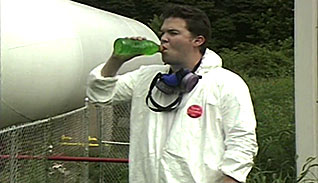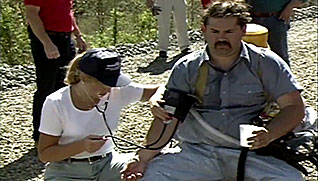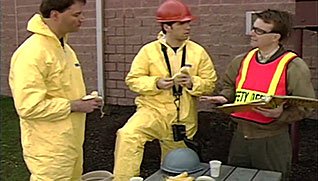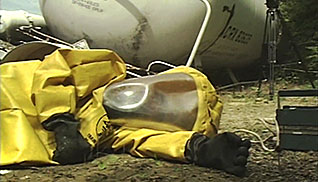HAZWOPER: Heat Stress
- Product ID
- marchwht_vod
- Training Time ?
- 18 to 25 minutes
- Language(s)
- English,Spanish
- Video Format
- High Definition
- Required Plugins
- None
- Number of Lessons
- 9
- Quiz Questions
- 7
- Question Feedback
- Wrong Answer Remediation
- Lesson Bookmarking
- Downloadable Resources



When working around hazardous materials your personal protective gear may present dangers to your health. Your chemical protective suit not only adds about 30 pounds to your body weight, it blocks air from reaching within the gear. The self-contained breathing apparatus contributes about 30 more pounds, and also prevents air exchange with the atmosphere. These conditions alone can make the body prone to overheating. Add hot ambient temperatures, and you have a recipe for a potentially fatal condition: heat stroke. This video explains how the body normally regulates its temperature, and how that process can be compromised by personal protective equipment. It stresses the importance of taking post-decontamination breaks on a regular basis and rehydrating with electrolyte-containing beverages to ward off heat stress and heat stroke.
Symptoms of heat stress, including heat rash, heat cramps and heat exhaustion are thoroughly explained, along with treatments for those conditions. Viewers learn the indicators of heat stroke, which can lead to brain damage or death, and how to respond if co-workers exhibit such symptoms. The video stresses that hazmat workers who suffer heat stroke inside a contamination zone are at even greater risk for injury or death, because they and their emergency evacuation team must be completely decontaminated before medical help can be given. This reinforces the need to properly hydrate and take heat-reducing breaks to manage hot environments.
Viewers also learn about the need to acclimatize to their PPE, inquire about heat-related side effects of prescription medications, eat light meals when working in chemical-resistant PPE, dress in lightweight, cotton or cotton-blend clothing that breaths and absorbs perspiration, and use ice vests for quick trips in contaminated zones.
Working around hazardous materials is inherently dangerous, and informed workers can learn to minimize the dangers posed by overheating. This video is an important tool in making workers and their managers aware of how to protect again heat illnesses, and what to do if they or a co-worker exhibits symptoms of heat stress or heat stroke. Watching this video can help ensure your workers will drive themselves home after their shift, instead of being driven to the hospital in an ambulance.
This course has been updated to include GHS container labels and Safety Data Sheets (SDS) for GHS compliance.
![]() This course is in the Video On Demand format, to read about Video On Demand features click here.
This course is in the Video On Demand format, to read about Video On Demand features click here.

- Full-screen video presentation
- Print certificate and wallet card
- You have 30 days to complete the course
All workers and supervisors involved in hazardous waste disposal or clean up
- Introduction
- How Your Body Cools Itself
- Fluids And Minerals
- Heat Rash Cramps And Exhaustion
- Heat Stroke
- First Aid
- Acclimatization
- Medications Food And Clothing
- Conclusion
© Mastery Technologies, Inc.


